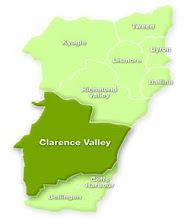 |
Banyam Baigham, The Sleeping Lizard
Click on image to enlarge
|
Michael
McDonald Macky Hercus and
Natalie Hercus (née
Michaels) appear to be ensconced in one half of a $5
milllion dollar duplex on a
leafy upmarket street in Point Piper, Sydney NSW. With her father
Harry occupying the other unit.
Michael
is the director and company secretary of Mackcorp Pty Ltd
whose sole shareholder is Hercus Investments Pty Ltd.
Hercus Investments in turn has both Michael & Natalie as directors and
Natalie as the sole shareholder. Michael is also sole director, sole
shareholder & company secretary of Allura Parklands Pty
Ltd.
This
former rugby union player & investment advisor and active
property developer along with his former Sky News presenter wife are whimsically classified by
realestate.com.au
among
the celebrity
buyers and sellers of
Sydney's waterside suburbs.
It
could be considered unfortunate that they chose to become active
participants in a move to effectively destroy the Widjabul
Wia-bal People's
spiritually and
culturally significant
Banyam
Baigham (the
Sleeping
Lizard).
In
was in May 2020 that the Winten
Property Group's
2018 proposal for a large-scale 433-lot
residential development
on the North Lismore Plateau was rejected
by the NSW Land & Environment Court.
In
May 2021 Michael
Hercus and
Allura Parklands Pty Ltd,
with other landholders Mr
A J & Mrs D L Purtle, Mrs V Giacomini, Giacmor Pty Limited, Mr F
Basso & Ms S Novkovic, Mrs M L & Mr G & Mrs L Mazzorana,
Mrs L Massorana and Mr A R & Mrs F M Riordan, submitted their own large-scale 742
lot residential development
plan for the same general area and had it refused
by the Northern Regional Planning Panel
(NRPP) in December 2022.
Refusing
to take no for an answer this 'celebrity buyers and sellers' couple,
through
Mackycorp Pty Ltd, presumably along with the other ten owners, have appealed the NRPP
decision
in the Land & Environment Court. In the process submitting the amended development proposal for 714 residential lots, including 7 large lots and 2 ‘super’ lots for future development), 2 neighbourhood business lots, plus residual lots, public reserves and associated infrastructure.
It
appears to matter not a jot to 45 year-old Michael and 46 year-old Natalie Hercus - or indeed
any of the other ten owners - that they are seeking to make money from the proposed destruction of a land form respected and guarded by a people and culture
which has existed on Country since time immemorial.
Given that Mackycorp's submitted Aboriginal Heritage Assessment (May 2024) indicates that many of the artefacts found on the proposed development site would on further investigation probably fall into a pre-1199 Common Era time period, this supports the presence of ancestors of the current Widjabul Wia-bal people living in the Lismore local government area since time immemorial.
It
probably wouldn't even occur to any of them that their connection to
the North Lismore Plateau is as ephemeral as the aerial lifespan of a
Mayfly when compared to the Widjabul
Wia-bal community's
presence there.
Banyam
Baigham, The Sleeping Lizard
Images:
Change.org & David Lowe
North
Lismore Plateau rejected development proposal with the light yellow section representing "Allura Parklands" containing 45 new roads, infrastructure and more than 700 residential dwellings. IMAGE: Echo, 18 January 2023.
ECHO,
18 January 2023:
On
Thursday 15 December, it took the four panellists on the Northern
Regional Planning Panel (NRPP) less than half an hour, to unanimously
decline the Development Application (DA) 5.2021.221.1 for the
northern section of the North Lismore Plateau (NLP) also known as The
Sleeping Lizard. Their overall reason? ‘Not in the public
interest’.
ECHO,
20 July 2024:
The
development of Lismore’s Sleeping Lizard – Banyam Biagham (the
North Lismore Plateau) as a 742-residential-lot subdivision was
rejected by the Northern Regional Planning Panel (NRPP) as ‘not in
the public interest’.
The
DA is the biggest single development ever proposed in Lismore and
includes massive bulk earthworks for infrastructure.
The
developer, Mackycorp, is continuing to appeal the NRPP rejection of
the staged development for 742 residential lots, two business lots, a
future residential lot, 45 new roads, bulk earthworks and significant
infrastructure following the failed Land and Environment Court (L&EC)
conciliation meeting in February this year.
On
July 15, 2024 Bundjalung Elder Mickey Ryan sought to join the ongoing
North Lismore Plateau Court appeal following the developer recently
submitting to the court a Cultural Heritage Assessment Report,
containing test pit results carried out earlier this year.
‘The
Report recommends that the developer obtain a permit to allow the
estimated half to 1.5 million sub-surface artefacts be directly
impacted by construction works, i.e harmed, destroyed or desecrated,’
explained Al Oshlack from the Indigenous Justice Advocacy Network
representing Mr Ryan. [my
yellow highlighting]
‘This
development with all its flaws such as traffic, flooding, storm
water, and even landslides will irretrievably destroy one of the most
significant Aboriginal sites in the Bundjalung country. It’s
vandalism and sacrilege to such a sacred place, this development is a
toxic mix of stupidity and greed,’ Mr Oshlack said.
Lismore
Council failed to defend Indigenous heritage
The
L&EC accepted the application by Mr Ryan to be a party to the
developer’s appeal to overturn the NRPP decision.
This
was based on the fact that Lismore
Council had chosen not to defend the cultural heritage of the site
despite this being one of the key factors in the NRPP refusing the
DA, Mr Oshlack told The Echo. [my
yellow highlighting]
‘In
the statement of facts and contentions Lismore Council was not going
to defend the Aboriginal cultural heritage component. Even though it
was a key basis for the rejection by the NRPP,’ he said.
‘The
developer strenuously objected to Mickey Ryan being allowed to join
the case.
‘Mickey
Ryan won the joinder on Monday based both on the arguments of public
interest and for justice – they were considered valid by the court
thus Mickey Ryan has now been joined as second responder.’
The
L&EC hearing is set down for an onsite hearing on August 12
followed by four days in Sydney.
NOTE: The Widjabul Wia-bal are recognised in law as holding native title over more than 11,500 hectares of what remains of their land and waters held by public authorities/government agencies in the Lismore local government area.
 IMAGE: Nationwide News, 26 July 2024
IMAGE: Nationwide News, 26 July 2024












